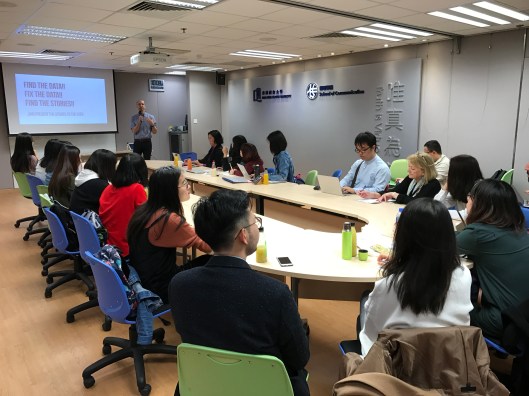Tags
At the first Data & News Society Colloquium of 2017, Jonathan Soma, from Columbia Journalism School, shared his ideas on Data and Visual Design in Journalism on Feb.20th.

(Photo by Bobo WEI)
Jonathan Soma is director of Columbia Journalism School’s Lede Program (http://ledeprogram.com/), a postgraduate data- and programming-intensive course. As an educator, programmer, and designer, he focuses on making unapproachable data accessible. Soma has made award-winning apps and worked with ProPublica, The New York Times, and others.
For any data story, Soma said, encoding and decoding of the data is necessary. Encoding describes how the journalist chooses to express the data, while decoding describes how a reader interprets the data. Graphs can be helpful for simplifying understanding on the part of the reader. Soma said journalists need to make sure the labels, guidelines or colors are meaningful and helpful.

(Photo by Bobo WEI)
How can a data journalist easily and quickly improve visualisations? Soma shared his five tips for data visualization:
1) Focus. The point of visualization is not to put all of the data onto the page. Soma suggested that as a data journalist, one should highlight the crucial points that enhance the story, and avoid distracting the reader with unnecessary information. He suggested using categories with different colors to highlight similar data points.
2) Keep your lines in line. While showing the data, show your user only what they need to know. Anytime you put the dots on the chart, there should be a reason, Soma said, and if the information not important, putting them in gray can be helpful.
3) Beautiful legends. The simpler the visual is, the more your readers can pay attention to. In other words, too many numbers or colors to differentiate only frustrate the audience.
4) Bar and column graphs. When you are not sure which graph you need, bar and column are usually good enough, Soma said. He suggested keeping the bars in order and directly labeling if you have just a few data points, instead of making the reader have to determine data points based on grid lines.

(Photo by Bobo WEI)
Soma stressed that the more data you are trying to show, the less information the readers can see. As a journalist, if you write a story, you are writing to provide information to your readers and to get the story across, he said.
He also discussed using pictures versus using data visuals in terms of which one is more useful to getting potential audience to read the article. Soma believes that whichever one more appropriately conveys the meaning of the article is best.
“I think there is a big fight in the world of data visualization. You want readers to pay attention. It is completely valuable to go for photos or go to other things.” Soma said, What you need to do is to convince people what they need to know, he said, and it can be balanced.
He also shared that for data-driven journalists, it is fine to not have a programming background. The core of data journalism is journalism, he explained, while data just helps to improve your stories.

Soma is also famous as the “Dating Expert” of ELLE magazine.
If you are interested in his work, here are some data journalism pieces by Soma: http://www.xoxosoma.com/
